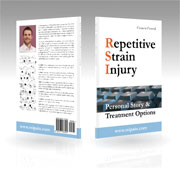Strengthening
Strengthening exercises for chronic RSI
If you have/had a chronic form of RSI (six months or more) strengthening exercises are important for restoring the former muscle power. But if you start too early or too excessively, you could act counterproductively. If you are still in constant pain, it's definitely too early! After you have done the exercises shown on my other pages for several weeks, your complaints should have at least temporarily improved. Now you can slowly begin to strengthen your upper body, because strong muscles can handle repetitive tasks better.
As a start, you should swim twice a week, so you build a solid foundation. You should avoid breaststroke because the hyperlordosis might amplify neck and back problems. Backstroke and crawl are preferred. Depending on your fitness level, you can add the exercises listed here 2-4 weeks later (every two to three days, see treatment plans). The first two weeks you should start easily and see what your body tolerates. Over time, you might find some exercises are too easy. Then you can increase the repetitions, extend the holding time or do a second round.
Especially exercises in which some of the body weight lies on the hands were unimaginable for me in the first few months. Please only do the exercises that you can perform without pain. Even after more than six months with the basic exercises I could not hold my body weight for pull-ups. Begin carefully and gradually try more exercises. "The more the better" is NOT what you should strive for. Overstressing your body could set you back several weeks, do not take any risk!
Strengthening exercises for mild discomforts
Athletically trained people have a lower risk of developing RSI, they profit from the increased endurance of their muscles. If you only have mild pain and you want to enter directly into phase four, you should initially focus solely on stretching exercises and other measures. Only after seeing an improvement should you start with strengthening exercises.
Risks
Many people do not always use the appropriate muscles for certain motions, but (unconsciously) compensate with adjacent muscles. The stronger the muscles are, the longer you won't feel any pain. But especially those adjacent muscles, which do most of the work, might fail at some point. In this case, you will not be able to restore the normal state with these strengthening exercises; you might even make the situation worse!
Hence I advise you to print out this page and go to see a good physical therapist.
He/she will watch you closely doing all exercises and can correct the execution if necessary. Since no body and not every problem is the same, he/she might be able to show you additional exercises, specially tailored for you.
Execution
It is important that you perform the exercises correctly. It would be counterproductive to use too much additional weight. Stick to the comments and continue breathing. Always keep your body tension. Otherwise you would stress your ligaments and tendons, without having a training effect for your muscles.
Muscles do not grow while performing an exercise, but only some time later in the resting phase (supercompensation). Every muscle needs a different amount of time to fully regenerate. As a rule of thumb: rest for 48 hours after each round of strengthening exercises.
Unless otherwise indicated, static exercises should be held for about 15 seconds for each side. Dynamic exercises should be repeated at least 7 times. One round of exercises with short breaks will take you 20 to 30 minutes.
Some of the exercises can be conducted with a foam roller (see trigger point massage). In addition to strengthening your body, you are then training your fascia at the same time.
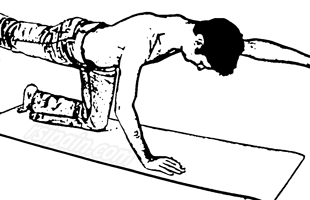
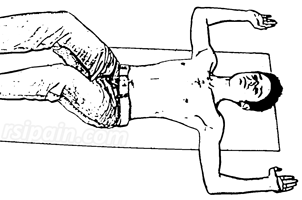
Core strengthening 1: In the neutral position you kneel on the floor and have both hands on the floor as well (arms straight). Knee, hip and shoulder joints are located at a 90° angle. Keep your head and neck in line with your spine and look down. Now lift one leg and the opposite arm, so that they form a horizontal line. Hold this position and then switch sides.
Core strengthening 2 (1-2 minutes): Lie on your back, legs still on the ground and keep your arms in a U-position (90°, see image). Press the entire body in line with your elbows down on the floor (at each point with the same force). Hold this position briefly. In addition try to press your entire spine evenly against the floor. Hold this position for 15-20 seconds. Now lift both legs and pull them up to a 90° angle. Push them slightly forward, with your spine still on the floor (see image).
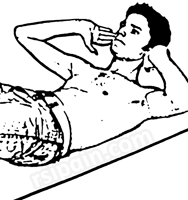
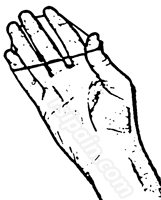
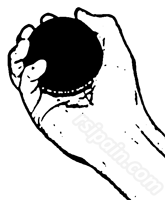
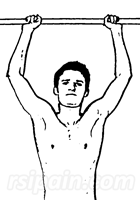
Crunches: Lie on your back with your knees bent. Lift your upper back slightly off the ground and stay in this position for a few seconds. Then lower your upper body slowly to the starting position. Repeat this exercise six times. The further you move your hands towards your head, the more difficult the exercise will become. Do not pull your head with your hands!
You should do another round for your
oblique muscles: raise your upper body slightly to the right. Repeat right and left each six times.
Finger extensors: Spread your fingers against the resistance of a rubber band.
Forearm and hand strengthening: A gyroscopic exerciser (price:
![]()
![]()
)
is a tennis-ball sized gyroscope which is powered by circular wrist motions. Despite its low weight, it feels like lifting dumb bells. The faster you spin the mass inside the shell, the more difficult it becomes.
Pull-ups: Proper pull-ups can only be recommended as prevention (phase 5). You can individually reduce the strain by supporting your body weight with your feet.
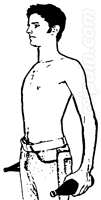
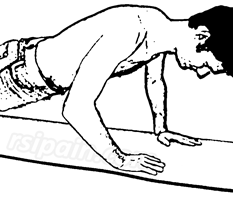
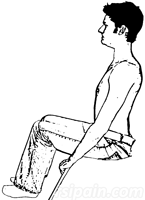
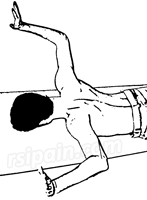
Shoulder strengthening 1: Take a bottle of water in each hand and circle your shoulders slowly backwards.
Pushups: Like pull-ups, pushups are only for prevention. To reduce the load, you can put your knees on the ground instead of your feet.
Core strengthening 3: Sit on the edge of a bed and lift your feet a few centimeters off the ground. Keep your back straight.
Shoulder strengthening 2: Lie on your stomach and lift your head slightly, without kinking the neck. Move your arms slowly up and down in each of the following positions:
a) Arms lying alongside your body (back of the hands facing up)
b) Arms to the side (thumbs up). Maximize the distance between both hands so that your shoulder blades stay apart.
c) Arms in U-position (hands upwards, see image).
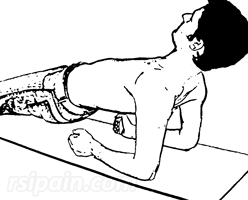
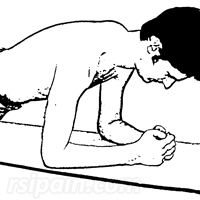
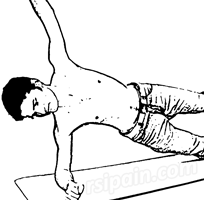
Back plank: Legs and torso form a straight line.
Front plank: The front plank is the wrist-friendly alternative to pushups. Legs and torso form a straight line.
Side plank: Legs and torso form a straight line. You can also put the upper arm alongside your body.
